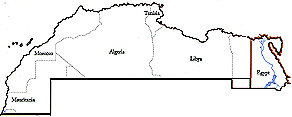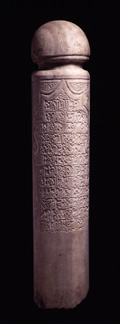
NORTHERN AFRICA

NORTHERN AFRICA

Gravestone, Kairouan, Tunisia, AD 1052>, marble, h. 114 cm., Musée des Arts d'Afrique et d'Océnie, Paris
Artistic expression - preserved in rock engravings and paintings, and stone utensils and sculpture - developed in northwestern Africa during the Neolithic period, which lasted from the seventh to the first millennium B.C. By the eighth century B.C., Phoenician traders from what is now Lebanon had founded colonies at harbor sites along the coast.
The most important of these was Carthage, whose style was an amalgam of Egyptian, Greek, and Phoenician influences.
After the defeat of Carthage in the second century B.C., northern Africa became a prosperous part of the Roman Empire, making its own distinctive artistic contribution in the fields of relief sculpture and polychromed floor mosaics.
In the seventh century A.D., Muslim armies from Arabia dislodged the forces of the Romans' successors, the Byzantines, from northwestern Africa. The region became linked culturally to the Islamic lands to the east, as well as to Muslim Spain. Yet the indigenous population, though converted to Islam, did not abandon its own language and culture. Trade with western sub-Saharan Africa and with western Sudan brought wealth to the Islamic dynasties of northern Africa and introduced Islam and its ar t and architecture to these areas. Much of the trade was conducted by Saharan nomads - the Arabic-speaking "Moors" of the western Sahara and the Tuareg of the central and southern Sahara - using camels, which had become a means of transport at the end of the Roman period. While early objects have been preserved in urban centers, the rural arts of the nomads living in mountain and desert regions were documented by ethnographers only in the late-nineteenth and twentieth centuries.
Lady's Belt (hzam), Fez, Morocco, 19th Century, silk lampas, 323 x 41 cm., Musée des Arts d'Afrique et d'Océnie, Paris
Egypt flourished again during the Islamic period, especially under the independent Fatimid (969-1171) and Mamluk (1250-1517) dynasties. The Fatimids, whose power base had been in what is today Libya, annexed Egypt and founded th eir new capital at Cairo (from the Arabic for "victorious"), where the luxury of their court became legendary. During the Mamluk period, Cairo became the spiritual and political center of the Islamic world, and the center of a commercial empire that monop olized not only the spice trade but also the trade in luxury goods between China and the West.
After the Mamluks' defeat by the Ottoman Turks, Egypt became part of the Ottoman Empire, and remained so until the nineteenth century.
<- Back to the Main Index Page
<- To the Clickable Map of Africa ->
<-To Programs and Events in Conjunction with this Exhibition ->
![]()